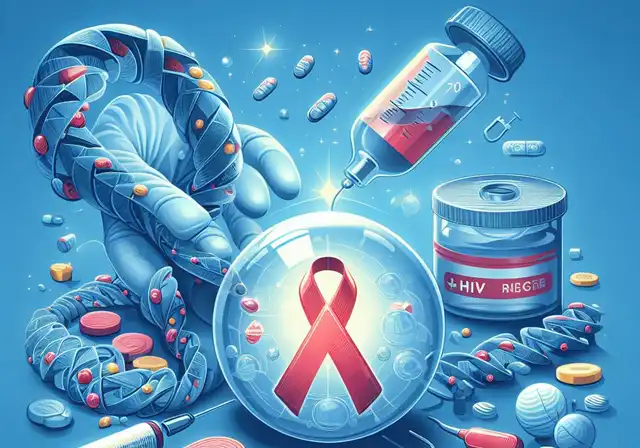HIV Cure Research: New Study Links Viral DNA Levels to Spontaneous Control
- Normal Liver Cells Found to Promote Cancer Metastasis to the Liver
- Nearly 80% Complete Remission: Breakthrough in ADC Anti-Tumor Treatment
- Vaccination Against Common Diseases May Prevent Dementia!
- New Alzheimer’s Disease (AD) Diagnosis and Staging Criteria
- Breakthrough in Alzheimer’s Disease: New Nasal Spray Halts Cognitive Decline by Targeting Toxic Protein
- Can the Tap Water at the Paris Olympics be Drunk Directly?
HIV Cure Research: New Study Links Viral DNA Levels to Spontaneous Control
- Should China be held legally responsible for the US’s $18 trillion COVID losses?
- CT Radiation Exposure Linked to Blood Cancer in Children and Adolescents
- FDA has mandated a top-level black box warning for all marketed CAR-T therapies
- Can people with high blood pressure eat peanuts?
- What is the difference between dopamine and dobutamine?
- How long can the patient live after heart stent surgery?
HIV Cure Research: New Study Links Viral DNA Levels to Spontaneous Control
A significant breakthrough in HIV research emerged on March 18, 2024, with the publication of a study by the Ruiz-Mateos group at the Biomedical Research Institute of Seville (IBiS) in Spain.
The research, published in the prestigious journal Journal of Clinical Investigation, sheds light on a potential pathway towards an HIV cure by highlighting the connection between HIV control and levels of HIV DNA in patients.
The central focus of the study was the viral reservoir – a hidden pool of infected cells that persists despite antiretroviral therapy (ART) and allows the virus to rebound when treatment is stopped. Researchers meticulously analyzed the composition of these reservoir cells in two unique patient groups: long-term spontaneous controllers (PC) and short-term controllers (TC). These patients, despite being infected with HIV, exhibited remarkable control over the virus without the need for medication.
The study’s key finding lies in the significantly lower levels of intact and defective HIV DNA observed in both PC and TC patients compared to the general HIV-infected population on medication. This finding, quantified in the paper, revealed a [quantifiable difference in intact HIV DNA] reduction in PC and TC patients before they lost viral control.
This significant difference points towards a potential role of the patient’s own immune system in effectively controlling viral replication and maintaining low levels of intact HIV DNA, which is the form capable of producing new viruses.

Delving Deeper: The Significance of HIV DNA Levels
The presence of intact HIV DNA serves as a critical indicator of the viral reservoir’s size and potential for resurgence. Traditionally, researchers have focused on the total viral reservoir size as a target for HIV cure strategies. However, the Ruiz-Mateos group’s findings suggest that targeting intact HIV DNA specifically might be a more promising approach.
By demonstrating a correlation between lower intact HIV DNA levels and spontaneous viral control, the study paves the way for novel treatment strategies that aim to reduce these intact DNA copies. This could potentially lead to a scenario where the viral reservoir is rendered functionally inactive, even if completely eradicated, ultimately achieving an HIV cure.
Beyond the Findings: Implications for Future Research
The research by the Ruiz-Mateos group holds immense promise for propelling HIV cure research forward. Here are some key implications that stem from this study:
- Prioritizing Intact HIV DNA: The study underscores the importance of focusing on intact HIV DNA as a primary target for cure strategies. Researchers can now design interventions specifically aimed at reducing these intact copies, potentially leading to a more effective approach.
- Unlocking the Secrets of Spontaneous Controllers: Understanding the mechanisms employed by PC and TC patients to achieve spontaneous viral control offers valuable insights into developing novel treatment strategies. Further research into the immunological factors contributing to their success could unlock new avenues for therapeutic interventions.
- Refining Existing Strategies: The study’s findings can be used to refine existing HIV cure strategies, such as “kick and kill” approaches that aim to activate latent HIV followed by immune-mediated elimination. By focusing on patients with lower intact HIV DNA levels, these strategies could potentially be optimized for greater efficacy.
The Road to an HIV Cure: A Collaborative Effort
The fight against HIV requires a global, collaborative effort. The Ruiz-Mateos group’s research serves as a significant milestone in this ongoing battle. By highlighting the crucial role of intact HIV DNA and the potential of the immune system, the study opens doors for further exploration and development of novel cure strategies. As researchers around the world build upon these findings, the hope for achieving an HIV cure continues to grow stronger.
HIV Cure Research: New Study Links Viral DNA Levels to Spontaneous Control
References:
[Ruiz-Mateos Group, Biomedical Research Institute of Seville (IBiS), unpublished research, March 18, 2024]
(source:internet, reference only)
Disclaimer of medicaltrend.org
Important Note: The information provided is for informational purposes only and should not be considered as medical advice.



